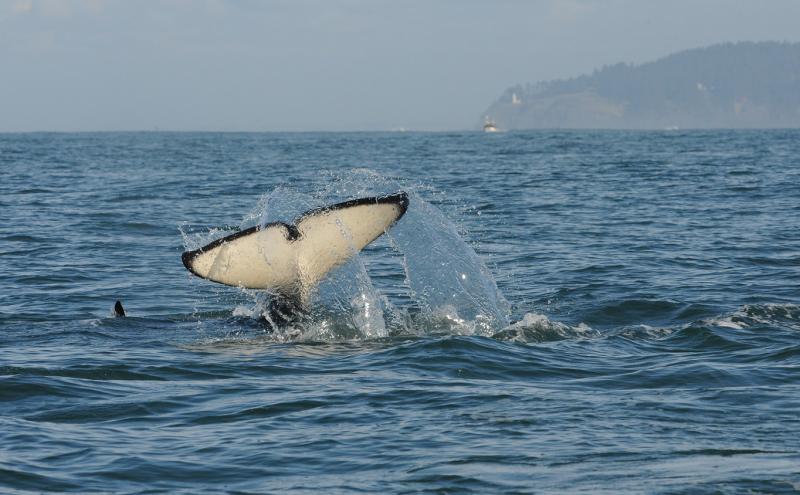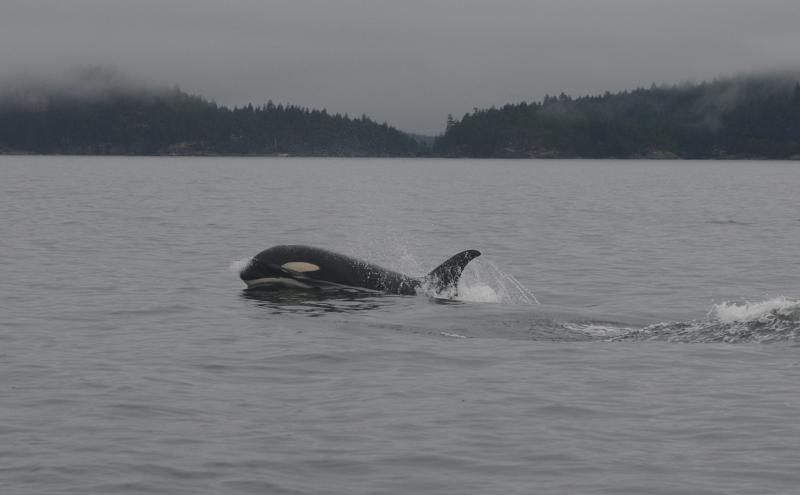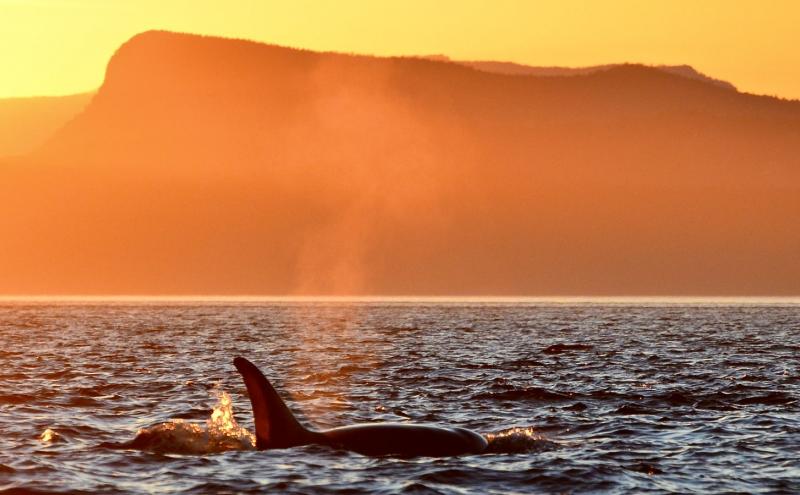
Central Puget Sound is home to several species of threatened and endangered marine mammals, birds, and fish — most notably Southern Resident killer whales, an iconic and beloved species in our region. Underwater noise impacts their ability to feed, communicate, navigate, reproduce, and avoid danger. In fact, the Washington Department of Fish and Wildlife cites underwater noise as one of the top three threats to the southern resident killer whale population.
The other side of the story is that human residents of our region need Port-related services to travel, transport goods between the Pacific Northwest and the rest of the world, and drive the region’s economy. The Port believes that the needs of all residents, both finned and footed, can be met. That’s why the Port’s mission statement, the Century Agenda, has set a goal for the Port to be the greenest and most energy-efficient port in North America.
Underwater noise mitigation
The Underwater Noise Mitigation and Management Plan is another step towards making this happen. The goal is to reduce underwater noise and its impact on marine mammals and other sensitive species in operations controlled or influenced by the Port. The Plan outlines how the Port will take steps to decrease impacts from noise at Port facilities including cruise terminals, fishing and commercial marinas, recreational marinas, the grain terminal, maritime properties, and waterfront parks. The Plan focuses on Port operations areas in Central Puget Sound, which includes Elliott Bay, Shilshole Bay, Salmon Bay, Lake Washington Ship Canal, and the Duwamish River; but it also identifies opportunities to reduce impacts from underwater noise at facilities owned by the Port of Seattle and managed by the Northwest Seaport Alliance, a marine cargo partnership between the ports of Seattle and Tacoma.
What’s the cause of underwater noise?
The primary sources of underwater noise in the Port operations area are in-water construction and vessel operations. Since the Port has a role in these activities, the Port has committed to using the tools it has available to better understand the sources of underwater noise and take steps to reduce underwater noise impacts on marine species.
In-water construction noise sources include pile driving, pile removal, and dredging. Pile driving can increase noise levels to volumes that cause hearing threshold shifts in marine mammals if not mitigated.
Vessels contribute noise to the aquatic environment through propulsion systems, machinery, and flow from the hull shape as it passes through the water. Vessel noise reduces usable space for aquatic species that rely on sound for communication, navigation, orientation, and hunting. Noise volume and its effects on marine species vary by activity and associated sound intensity, frequency, duration, and timing.
Green Marine Certification
First, some background on underwater noise and why the Port is addressing it.
The Port of Seattle was the first West Coast port to be certified by the Green Marine environmental program, which is a voluntary environmental certification program that encourages its participants to reduce their environmental footprint by taking concrete actions.
Participants benchmark their annual environmental performance against Green Marine criteria, and the results are verified by an accredited external verifier and published for transparency.
It’s a rigorous evaluation that addresses key environmental issues through a total of 14 performance indicators, including:
- Aquatic invasive species
- Greenhouse gases and air pollution
- Spill prevention
- Dry bulk storage
- Community impact
- Environmental leadership
- Waste management
- Underwater noise
In 2020, the Port earned credit for all relevant performance indicators, with a score of 5 out of 5 for each indicator except for underwater noise, for which the Port earned 2 out of 5 — still a significant accomplishment!
Development of the Underwater Noise Mitigation and Management Plan will improve the Port’s certification level from a 2 to a 3. The actions in the plan also provide a framework to advance to Level 4 and Level 5 certification!
Who’s impacted by environmental noise?
The simple answer is “all of us.” But more specifically, the waters of our region (and the Port’s operational areas) are home to nine endangered species that are adversely impacted by underwater noise.
In addition to the iconic Southern Resident killer whale, these endangered species can also benefit from efforts to reduce underwater noise:
- Puget Sound Chinook salmon
- Puget Sound steelhead trout
- Bull trout
- Bocaccio and yelloweye rockfish
- Humpback whales
- Marbled murrelets
- Leatherback turtles
The local marine environment also hosts transient killer whales, gray whales, minke whales, bottlenose and common dolphins, harbor porpoises, Steller sea lions, California sea lions, and harbor seals. Reducing underwater noise is the right thing to do and fins and feet will all benefit from it.
What’s the plan to reduce noise?
The Underwater Noise Mitigation and Management Plan outlines steps the Port is already taking and identifies opportunities for future work to help reduce the impacts of underwater noise on sensitive species. The Port complies with its legal responsibilities as a facility owner and operator but does not have direct or regulatory control over many noise-generating activities that may impact marine mammals, fish, and birds. Therefore, the Plan focuses on how the Port can leverage its influence to reduce noise through leadership, investment, collaboration, and advocacy. The goal is to create a world where commerce, communities, and keystone species can co-exist sustainably.
The Port has committed to reducing noise by:
- Leading as an environmentally responsible steward of marine facilities
- Advocating for sound policy, regulations, and practices related to underwater noise
- Funding studies that advance scientific knowledge
- Partnering with industry, government agencies, tribes, and non-profits
Planning for quiet
The Underwater Noise Mitigation and Management Plan is the next step in achieving further certification levels in the Green Marine underwater noise category. The Port has committed to completing the plan in 2022.
Level 1:
Monitor regulations. Work with NOAA to implement best management practices (BMPs) like mammal monitoring and installing double-walled piling.
Level 2:
Outreach and education — outreach to Port tenants, working to promote WRAS usage, and mapping impact zones from pile driving. The Port is currently at Level 2.
Level 3:
Complete the plan and continue to execute underwater noise mitigation and management efforts identified in the plan.
Achieving Level 4 and Level 5 will require the Port to establish underwater noise reduction goals and then measure progress towards attaining them.
Mitigation in progress
The Port has already been working on mitigation of underwater noise and has conducted the following activities in 2022:
- Measured underwater noise levels during dredging against background noise levels
- Funded a study conducted by the University of Washington (UW) and the National Oceanic and Atmospheric Association (NOAA) of the hydrophone network in the Salish Sea
- Launched an Ambient Noise Assessment Program to collect baseline underwater noise data in Elliott Bay
Watch the Port environmental team place a hydrophone (an underwater microphone) for baseline noise measurement
The Port has identified the following opportunities for future work in 2023-2024:
- With any remaining funds from the UW/NOAA study, purchasing hydrophone equipment to improve the regional monitoring network
- Measuring background noise levels in Elliott Bay through the Ambient Noise Assessment Program
Top photo credit: "Southern Resident killer whales" by NOAA Fisheries West Coast is licensed under CC BY-NC-ND 2.0.






